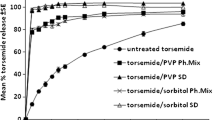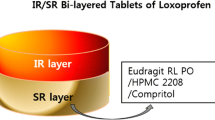Abstract
Response surface methodology is defined as a collection of mathematical and statistical methods that are used to develop, improve, or optimize a product or process. In the present study, a statistical design (Mixture Design) was employed for formulation and optimization of a sustained-release hydrophilic divalproex sodium matrix tablet. Different excipients were used to improve the drug’s poor flowability. The hardness of the prepared tablets and also their release pattern were tested. The formulation design was carried out employing mixture design using four excipients in three levels. The Carr’s index of formulations and tensile strength were determined and analyzed using Minitab software. The suitable formulations regarding flowability and tablet tensile strength were selected by this software for subsequent drug release studies. The dissolution tests were carried out in acidic and basic phases which were previously proved to be biomimetic. Samples were analyzed using HPLC, and release data were compared to Depakine® (sustained-release divalproex from Sanofi). Release kinetics was also determined for selected formulations. Selected formulations were subjected to dissolution test and showed similar dissolution profiles with Depakine® based on difference and similarity factor calculations. The software selected an optimized formulation which had a slightly different release pattern in vitro compared to innovator but of nearly zero-order kinetics. It can be concluded that application of Mixture Design is a shortcut method to design suitable formulations of sustained-release divalproex sodium containing hydrophilic matrix tablets by direct compression method.







Similar content being viewed by others
REFERENCES
Chow SC. Encyclopedia of biopharmaceutical statistics. New York: Marcel Dekker; 2003.
Chopra S, Patil GV, Motwani SK. Release modulating hydrophilic matrix systems of losartan potassium: optimization of formulation using statistical experimental design. Eur J Pharm Biopharm. 2007;66:73–82.
Ren S, Mu H, Alchaer F, Chtatou A, Müllertz A. Optimization of self nanoemulsifying drug delivery system for poorly water-soluble drug using response surface methodology. Drug Dev Ind Pharm 2012; 1–8. (doi:10.3109/03639045.2012.710634)
Singh G, Pai RS, Devi VK. Response surface methodology and process optimization of sustained release pellets using Taguchi orthogonal array design and central composite design. J Adv Pharmaceut Tech Res. 2012;3:30.
Minitab. Minitab online Help, Copyright © 2003–2005 Minitab Inc. Available from: http://www.scribd.com/doc/17451466/15/Response-Optimizer. Accessed 2012 September.
Qiu Y, Cheskin HS, Engh KR, Poska RP. Once a day controlled release dosage form of divalproex sodium I: formulation design and in vitro/in vivo investigations. J Pharm Sci. 2003;92:1166–73.
rxlist. The Internet Drug Index-Sodium Valproate. Available from: http://www.rxlist.com/depacon-drug.htm. Accessed 2012 September.
rxlist. The Internet Drug Index. Available from: http://www.rxlist.com/depakote-er-drug.htm. Accessed 2012 September.
Bialer M. Extended-release formulations for the treatment of epilepsy. CNS Drugs. 2007;21:765–74.
Dutta S, Reed RC. Divalproex to divalproex extended release conversion. Clin Drug Investig. 2004;24:495–508.
Centorrino F, Kelleher JP, Berry JM, Salvatore P, Eakin M, Fogarty KV, Fellman V, Baldessarini RJ. Pilot comparison of extended-release and standard preparations of divalproex sodium in patients with bipolar and schizoaffective disorders. Am J Psychiatry. 2003;160:1348–50.
Phaechamud T, Mueannoom W, Tuntarawongsa S, Chitrattha S. Preparation of coated valproic acid and sodium valproate sustained-release matrix tablets. Indian J Pharmaceut Sci. 2010;72:173.
Dutta S, Zhang Y, Selness DS, Lee LL, Williams LA, Sommerville KW. Comparison of the bioavailability of unequal doses of divalproex sodium extended-release formulation relative to the delayed-release formulation in healthy volunteers. Epilepsy Res. 2002;49:1–10.
Zeng XM, Martin GP, Marriott C, Pritchard J. The effects of carrier size and morphology on the dispersion of salbutamol sulphate after aerosolization at different flow rates. J Pharm Pharmacol. 2000;52:1211–21.
Rowe RC, Sheskey PJ, Owen SC, American Pharmacists A, Library R. Handbook of pharmaceutical excipients, vol. 4. London: Pharmaceutical Press; 2006.
Parrott EL, Lachman L, Lieberman HA, Kanig JL. The theory and practice of industrial pharmacy. Philadelphia: Lea & Febiger; 1986. p. 317–56.
Qiu Y, Garren J, Samara E, Cao G, Abraham C, Cheskin HS, Engh KR. Once a day controlled release dosage form of divalproex sodium II: development of a predictive in vitro drug release method. J Pharm Sci. 2003;92:2317–25.
United States Pharmacopoeial C., USP 32: United States Pharmacopoeia 32 and National Formulary No 27. 2010, Mack Printing Rockville.
Emery E, Oliver J, Pugsley T, Sharma J, Zhou J. Flowability of moist pharmaceutical powders. Powder Technol. 2009;189:409–15.
Cai L, Xiaoping C, Pan X, Bo L, Changsui Z, Chuanlong X. Effect of moisture content on conveying characteristics of pulverized coal for pressurized entrained flow gasification. Experimental Thermal and Fluid Science. 2011.
Simons SJR. Liquid bridges in granules. Handbook Powder Tech. 2007;11:1257–316.
Ajay LB, Santosh NS, Monali SS, Kunal DI, Vishnu PC, Bhanudas SK. Fabrication of controlled release metoprolol succinate matrix tablet: influence of some hydrophilic polymers on the release rate and in-vitro evaluation. Int J Pharma World Res. 2010;1:1–15.
Carney EE, Groesbeck CN, Goodband RD, Tokach MD, Nelssen JL, Dirtz SS. Lactose and specialty protein sources influence flowability of nursery pig diets. Swine Res. 2005;4:118–27.
Odeniyi MA, Abobarin TO, Aitiola O. Compressibility and flow characteristics of binary mixture of metronidazole with lactose and microcrystalline cellulose. Farmacia. 2008;6:625–38.
Shinde SN, Magdum SS, Shekhar B, Waikar MRM, Chandak KK. Development and evaluation of floating tablets of salbutamol sulphate. IJPRD. 2010;2:1–7.
Spireas S, Sadu S. Enhancement of prednisolone dissolution properties using liquisolid compacts. Int J Pharm. 1998;166:177–88.
Gohel MC, Jogani PD, Bariya SH. Development of agglomerated directly compressible diluent consisting of brittle and ductile materials. Pharm Dev Technol. 2003;8:143–51.
Jonat S, Hasenzahl S, Drechsler M, Albers P, Wagner KG, Schmidt PC. Investigation of compacted hydrophilic and hydrophobic colloidal silicon dioxides as glidants for pharmaceutical excipients. Powder Technol. 2004;141:31–43.
Gordon M, Chowhan ZT. The effect of aging on disintegrant efficiency in direct compression tablets with varied solubility and hygroscopicity, in terms of dissolution. Drug Dev Ind Pharm. 1990;16:437–47.
York P. Application of powder failure testing equipment in assessing effect of glidants on flowability of cohesive pharmaceutical powders. J Pharm Sci. 1975;64:1216–21.
Darmuzey O, MacLeod G, Cengic D, Stokes KM. Solid form. 2007, Google Patents.
Schwartz E, Fitchner V, Irlinger B, Haeusler O. Influence of lubricants on the tableting and disintegration time of tablets made up of coprecessed excipients vs. the physical blends. Proceedings of 5th world meeting on pharmaceutics, Biopharmaceutics and Pharmaceutical Technology, Geneva. 2006; 27–30.
Chowhan ZT. Role of binders in moisture induced hardness increase in compressed tablets and its effect on in vitro disintegration and dissolution. J Pharm Sci. 1980;69:1–4.
Arya RK, Chaurasia H, Bharadwaj P, Garud N, Palani S. Development and evaluation of mucoadhesive buccal tablets of salbutamol sulphate. Int J Pharmacy Pharm Sci. 2010;2:40–2.
Kavanagh N, Corrigan OI. Swelling and erosion properties of hydroxypropylmethylcellulose (Hypromellose) matrices—influence of agitation rate and dissolution medium composition. Int J Pharm. 2004;279:141–52.
Pygall SR, Kujawinski S, Timmins P, Melia CD. Mechanisms of drug release in citrate buffered HPMC matrices. Int J Pharm. 2009;370:110–20.
Katzhendler I, MÃder K, Friedman M. Structure and hydration properties of hydroxypropyl methylcellulose matrices containing naproxen and naproxen sodium. Int J Pharm. 2000;200:161–79.
Barzegar-Jalali M, Valizadeh H, Mohammadi G, Adibkia K. Analytical review of drug dissolution and release kinetic models. Pharmaceutical Sciences. 2009;14(4):191–207.
Barzegar-Jalali M, Adibkia K, Valizadeh H, Shadbad MRS, Nokhodchi A, Omidi Y, Mohammadi G, Nezhadi SH, Hasan M. Kinetic analysis of drug release from nanoparticles. J Pharm Pharm Sci. 2008;11:167–77.
ACKNOWLEDGMENTS
The authors are thankful to Tabriz University of Medical Sciences, Faculty of Pharmacy and Zahravi Co. Tabriz, Iran for supply of some ingredients.
Author information
Authors and Affiliations
Corresponding author
Rights and permissions
About this article
Cite this article
Monajjemzadeh, F., Hamishehkar, H., Zakeri-Milani, P. et al. Design and Optimization of Sustained-Release Divalproex Sodium Tablets with Response Surface Methodology. AAPS PharmSciTech 14, 245–253 (2013). https://doi.org/10.1208/s12249-012-9907-z
Received:
Accepted:
Published:
Issue Date:
DOI: https://doi.org/10.1208/s12249-012-9907-z




